In Telangana’s picturesque landscape, Bhongir Fort stands tall – a mighty guardian of the region’s rich past and architectural heritage. Perched atop a massive rock, this ancient fortress is hard to miss, offering stunning views of the surrounding countryside. As you explore Bhongir Fort, also known as Bhuvanagiri Fort, history comes alive. Travel back to an era of kings, warriors, and dynasties, where every stone whispers tales of bravery, conquest, and cultural exchange.
Dating back to the 10th century, Bhongir Fort has witnessed the rise and fall of empires – Kakatiyas, Chalukyas, Bahmanis – each leaving their mark on its rugged landscape. From its strategic rocky perch to its formidable walls and intricate carvings, Bhongir Fort continues to intrigue and inspire with its timeless allure.
How to reach:
Fly in: Rajiv Gandhi International Airport in Hyderabad, about 60 kilometers away, is the closest airport. Taxis and buses connect the airport to Bhongir, with a journey time of 1.5 to 2 hours depending on traffic.
Catch a Train: Bhongir Railway Station, just a few kilometers from the fort, is your best rail option. Board trains from Hyderabad, Secunderabad, or Warangal. Local taxis or auto-rickshaws can then whisk you to the fort’s doorstep.
Hit the Road: Bhongir Fort enjoys good road connectivity. Regular buses ply from Hyderabad, Warangal, and nearby towns. If you’re driving, take the Hyderabad-Warangal Highway (NH163) and follow signs towards the fort. The journey from Hyderabad is roughly 50 kilometers and takes about 1.5 to 2 hours by road, depending on traffic.
Local Rides: Once in Bhongir town, auto-rickshaws and taxis are readily available to take you to the fort. While the fort sits atop a hill, a short trek is manageable. For easier access, steps are carved into the rock leading up to the entrance.
Best time to visit:
Pleasant Weather for Exploration (October – February):
Bhongir Fort shines brightest during winter, October to February. Expect comfortable to mildly cool temperatures, perfect for exploring the fort and soaking in the scenery. Clear skies and pleasant weather make outdoor activities enjoyable, allowing you to fully appreciate the historical and natural beauty of the fort.
Beware the Summer Heat (March – May):
Telangana’s summer, March to May, is scorching. The intense heat can make exploring the fort uncomfortable. If you must visit during this time, pack plenty of water, sunscreen, and protective clothing to stay hydrated and shielded from the sun.
Monsoon Season (June – September):
The monsoon brings heavy rain and humidity to Telangana, June to September. While the landscape turns lush and green, slippery paths and muddy terrain can make exploring the fort challenging. It’s best to check weather forecasts before planning a monsoon visit to avoid any inconvenience.
Attractions:
The Fort Entrance:
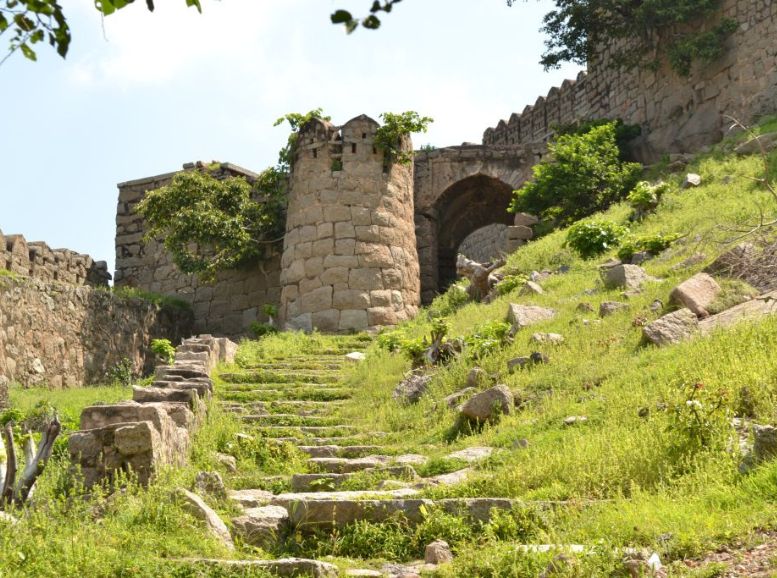
Bhongir Fort’s entrance isn’t just a passage; it’s a dramatic introduction to the fort’s rich history. Approaching visitors are met with a powerful first impression – a towering structure that hints at the fort’s past glory. The climb to the entrance is an adventure in itself. Massive stone steps, carved directly into the hillside, snake their way upwards. The effort is rewarded with stunning panoramic views of the surrounding landscape. The gateway itself is a masterpiece. Intricate carvings adorn the stone, while sturdy wooden doors hint at the fort’s strategic importance. Passing through this grand entrance is like stepping back in time. The very stones seem to whisper tales of battles fought, rulers who reigned, and the lives that unfolded within these ancient walls.
Rock-Cut Steps:
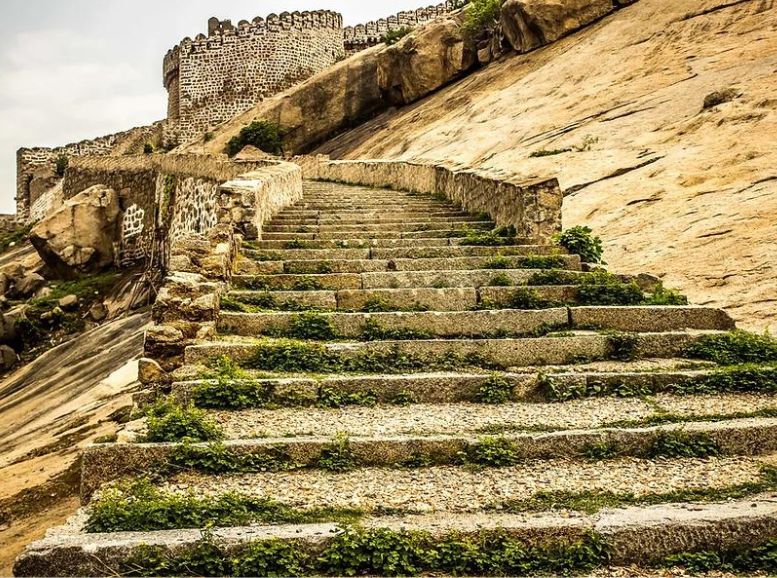
The defining characteristic of Bhongir Fort is its magnificent stairway carved directly into the granite belly of the hill. These steps are a testament to the ingenuity of ancient engineers. As you ascend, the path winds upwards, offering not just a physical climb but a growing appreciation for the immense effort required to create such a passage. Each step becomes a vantage point, revealing ever-expanding vistas of the lush countryside below, dotted with villages and emerald fields. Though the climb can be challenging at times, the sense of achievement upon reaching the summit is unrivaled. These aren’t simply steps; they’re a historical pathway, a journey back in time to the fort’s vibrant past and strategic significance.
Fortifications and Walls:
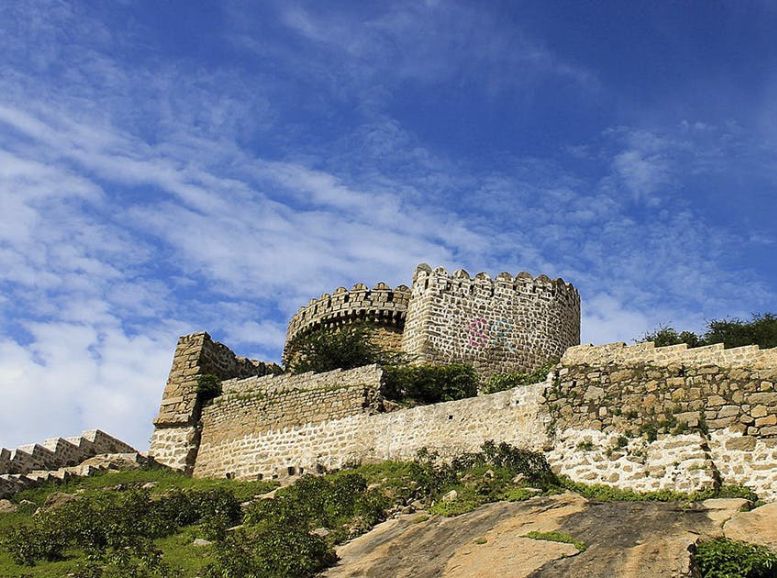
Bhongir Fort’s defenses are a stoic testament to its strategic significance. Towering walls, built from colossal blocks of stone, speak volumes about the fort’s role in withstanding assaults. A walk along these ramparts reveals the builder’s mastery of architecture and military strategy. Watchtowers and bastions punctuate the walls, offering not just expansive views of the surrounding landscape but also highlighting the fort’s dominance over the hilltop. But these fortifications are more than just functional. The intricate stonework and carvings adorning the walls hint at the artistic flair of the era. As you explore, you can almost picture the fort’s defenders keeping watch, ever alert against potential threats. History seems to seep from the very stones, each one whispering tales of those who depended on these fortifications for their safety.
The Citadel:
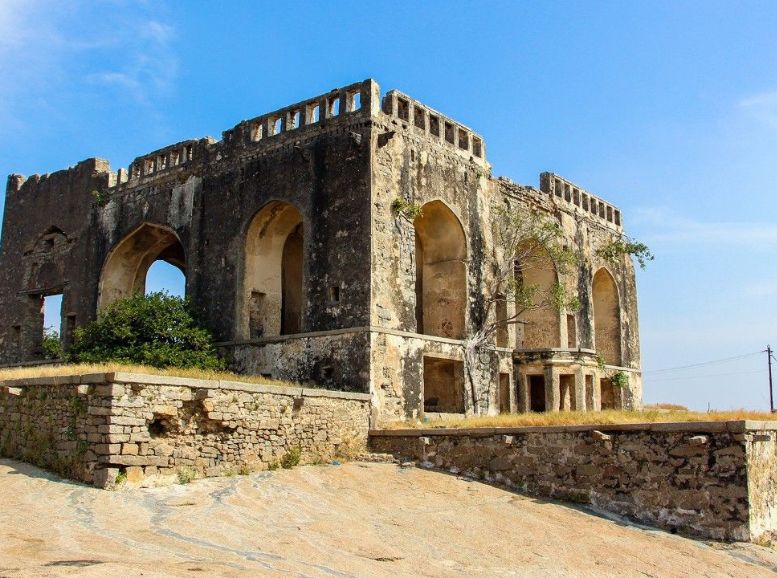
The crown jewel of Bhongir Fort is its citadel, the inner sanctum that once housed rulers and their families. This area offers a captivating glimpse into the past. Remnants of residences, administrative buildings, and storehouses peek through the ages, whispering stories of the fort’s inhabitants and their daily lives. The citadel was the fort’s beating heart, where decisions were made and strategies formulated. As you explore the ruins, your imagination can conjure the bustling energy of court life – messengers carrying news, officials conferring, residents enjoying moments of leisure. The architectural layout is a fascinating blend of practicality and beauty. Courtyards provided open space, balconies offered scenic vistas, and intricately carved pillars added a touch of elegance. Here, history isn’t confined to dusty textbooks. The citadel brings the past to life, offering a tangible connection to the fort’s role as a regional powerhouse.
Underground Chambers:
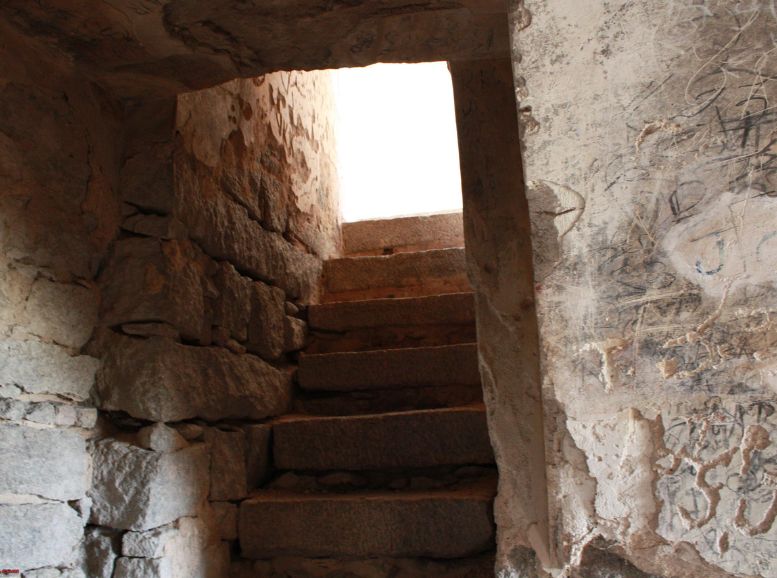
Bhongir Fort’s secrets lie not just above ground, but also beneath it. A network of subterranean chambers and tunnels weaves its way under the fort, adding a layer of intrigue to any exploration. These ingenious passages served multiple purposes. Imagine the strategic thinking that went into designing such a complex labyrinth! The cool, dark tunnels stand in stark contrast to the sun-drenched courtyards above. They functioned as a hidden lifeline, stockpiling food, water, and ammunition for the fort to endure long sieges. But their utility went beyond mere storage. In moments of desperation, these tunnels became secret escape routes, offering a path to safety for the fort’s inhabitants. The underground network is a marvel of planning, seamlessly blending military strategy with the very real need for survival. As you traverse these hidden pathways, a sense of wonder washes over you, a tribute to the foresight and ingenuity of the fort’s builders.
The Stepwell, Bhongir Fort:
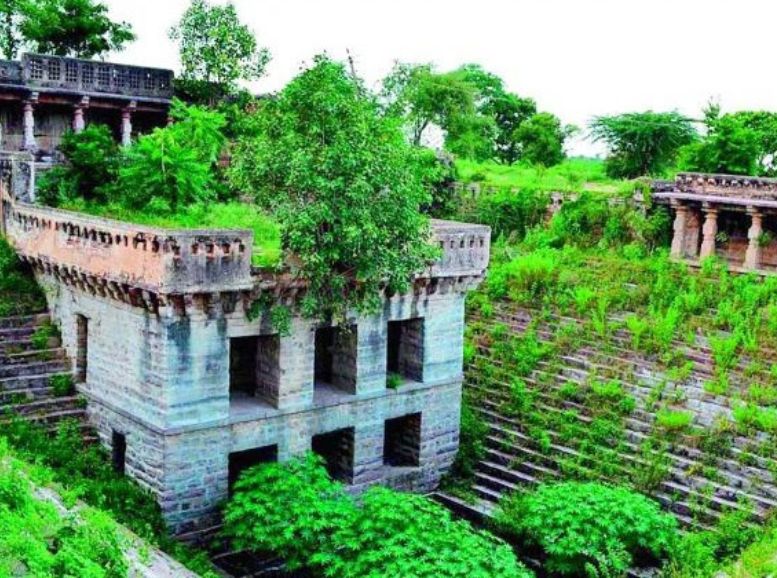
Bhongir Fort’s lifeblood wasn’t just soldiers and supplies, but also a dependable source of water – its ancient stepwell. This marvel of engineering ensured the fort’s inhabitants never went thirsty, even during times of siege. Imagine the foresight required to design such a vital structure! Stepwell access was ingenious. A series of descending steps led to the water source itself, ensuring a steady supply regardless of the water level. But the stepwell wasn’t just functional; it was beautiful. The intricate carvings that adorned the steps and walls showcased the artistic talents of the era. Exploring this wonder offers a glimpse into the resourcefulness of the fort’s builders. They ensured not just military might, but the ability to sustain life within the fort’s walls. The stepwell is a testament to both practicality and artistry, adding a unique layer to the fort’s charm and historical significance.
Local Experiences:
1. Spiritual Serenity and Historical Echoes: Bhongir Fort isn’t just a military marvel; it’s a haven for spiritual seekers and history buffs alike. Explore ancient temples nestled within the fort walls, or simply soak in the serene atmosphere steeped in centuries of history.
2. Birdwatching Paradise: Awaits at Ameenpur Lake: Nature enthusiasts, rejoice! A short distance away lies Ameenpur Lake, a haven for resident and migratory birds. Take an early morning or late afternoon stroll to witness a dazzling array of feathered friends.
3. Unveiling Local Crafts: Through Hands-on Workshops: Immerse yourself in the region’s rich cultural heritage by participating in workshops. Learn pottery-making techniques, traditional weaving methods, or whip up a local culinary masterpiece – all fostering a deeper appreciation for the area’s unique traditions.
4. Capture the Essence: Photography Tour around Bhongir: Embark on a photography tour to capture the essence of Bhongir. From the majestic Bhongir Fort itself to the picturesque landscapes and vibrant local life, there’s a frame-worthy scene around every corner. Aim for sunrise or sunset for truly breathtaking shots.
5. Unveiling the Rural Tapestry: Village Tours near Bhongir: Deepen your understanding of the local way of life with a guided village tour. Interact with welcoming villagers, learn about their customs and traditions, and witness agricultural practices firsthand. This cultural exchange fosters a deeper connection to the region’s soul.
Travel tips:
- Embrace Cooler Months: October to February offers pleasant weather for exploring the fort and surroundings.
- Sturdy Shoes are a Must: The terrain involves climbing, so comfortable, supportive footwear is key.
- Hydration is Your Ally: Pack plenty of water, especially during warmer months. The climb can be demanding.
- Beat the Crowds and Heat: Early mornings provide a peaceful environment with cooler temperatures.
- Sun Protection is Crucial: Pack sunscreen, sunglasses, and a hat for protection in open areas.
- Pack Light for the Climb: A backpack with essentials like water, snacks, and a first-aid kit is ideal.
- Be a Responsible Visitor: Help preserve the fort by avoiding littering, defacing structures, or disturbing wildlife.
- Uncover Hidden Gems: Consider hiring a local guide for a deeper dive into the fort’s history and architecture.
- Moderate Fitness Recommended: The climb can be challenging. Ensure you’re in good health and take breaks when needed.
- Check the Weather Forecast: Avoid visiting during heavy rains when paths become slippery.
- Don’t Forget Your Camera: Capture stunning panoramic views, especially during sunrise or sunset.
- Discover Nearby Treasures: Visit Yadadri Temple, Kolanupaka Jain Temple, or Surendrapuri Mythological Theme Park.
- Respect Local Traditions: Be mindful of local customs for a more enriching experience.
- Charge Your Phone: Ensure your phone is charged with emergency contact information saved. Mobile connectivity might be limited in some areas.
- Stay on Designated Paths: Avoid venturing into restricted or unsafe areas. Keep an eye on children.
- Take Your Time: Bhongir Fort boasts a rich history. Explore at your own pace to appreciate the details.
- Indulge in Local Flavors: Enjoy a traditional Telangana meal after your visit to experience the regional cuisine.
Conclusion
Telangana’s crown jewel, Bhongir Fort, beckons with its rich history, awe-inspiring architecture, and breathtaking landscapes. Xplro.com elevates your visit from a historical walkthrough to a vibrant immersion in the region’s cultural tapestry. Every corner of the fort, from the imposing entrance and hand-carved steps to the panoramic vistas and ancient temples, whispers tales of resilience, strategic brilliance, and artistic mastery. Whether you’re a history buff, a trekking enthusiast, or simply seeking serenity, Bhongir Fort promises an unforgettable experience. Plan your adventure with Xplro.com to discover the best time to visit, essential travel tips, and hidden treasures near the fort. Go beyond the walls – savor the region’s delectable cuisine, embrace the local customs, and witness Bhongir Fort not just as a monument, but as a living testament to Telangana’s rich heritage.
FAQs
1. What is Bhongir Fort?
- Bhongir Fort is a historic fortress located in Bhongir town, Telangana. Built in the 10th century, the fort sits atop a large rock hill and is renowned for its strategic significance and architectural beauty, offering spectacular views of the surrounding area.
2. How do I reach Bhongir Fort?
- Bhongir Fort is about 48 kilometers from Hyderabad. You can get there by taking National Highway 163. Public buses and taxis are available from Hyderabad, and the nearest railway station is Bhongir Railway Station, which is well-connected to major cities.
3. When is the best time to visit Bhongir Fort?
- The best time to visit Bhongir Fort is from October to February when the weather is cooler and more comfortable for exploring the fort and its surroundings.
4. What are the operating hours of Bhongir Fort?
- Bhongir Fort is usually open from early morning until evening. It’s best to start your visit early to avoid the midday heat and to have plenty of time to explore the site.
5. Is there an entry fee for Bhongir Fort?
- Yes, there is a small entry fee for visiting Bhongir Fort. The fee helps with the maintenance and preservation of the site. Check the latest fee before your visit, as it can change.
6. How long should I plan to spend at Bhongir Fort?
- Plan to spend between 2 to 4 hours at Bhongir Fort. This time frame includes the climb to the top and the exploration of various attractions within the fort.
7. What should I wear when visiting Bhongir Fort?
- Wear comfortable clothes and sturdy, non-slip shoes suitable for hiking and walking on uneven terrain. It’s also advisable to bring a hat, sunglasses, and sunscreen for sun protection.
8. Are guided tours available at Bhongir Fort?
- Yes, guided tours are available. Hiring a local guide can provide you with detailed information about the fort’s history, architecture, and the legends associated with it, enhancing your visit.
9. Is Bhongir Fort safe for children?
- Yes, Bhongir Fort is safe for children, but they should be closely supervised, especially when climbing the rock-cut steps and exploring the higher areas. Ensure they wear proper footwear and stay hydrated.
10. What facilities are available at Bhongir Fort?
- Basic facilities such as parking, restrooms, and drinking water are available near the fort entrance. It’s advisable to carry your own water and snacks, especially if you plan to explore for a few hours.
11. Can I bring food and drinks into Bhongir Fort?
- Yes, you can bring food and drinks. Carry water and light snacks, particularly if you plan to trek to the top. Remember to dispose of waste responsibly and keep the area clean.
12. What other attractions are near Bhongir Fort?
- Nearby attractions include the Yadadri Temple, Kolanupaka Jain Temple, and Surendrapuri Mythological Theme Park. These sites offer additional cultural, religious, and historical experiences, making them worthwhile stops during your visit.





